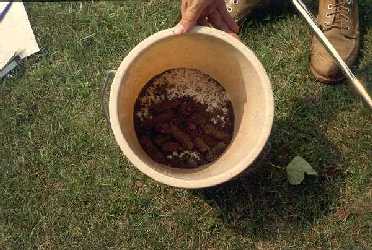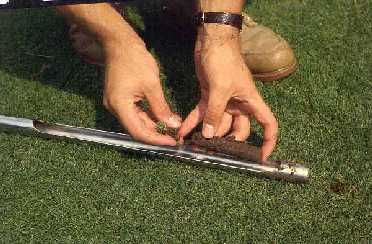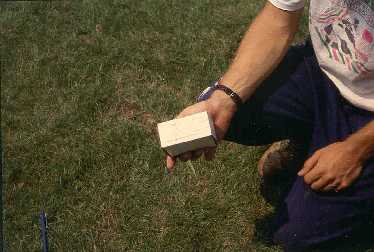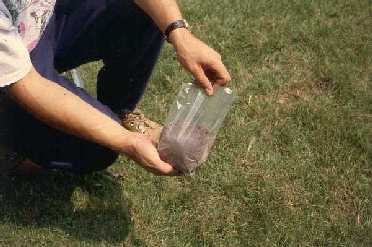Soil testing for turf
Learn how to soil test to determine the amounts of potassium, phosphorus and magnesium fertilizers and lime to be applied to turf.
Why use soil tests?
The Ontario Ministry of Agriculture, Food and Rural Affairs soil tests are used to determine the amounts of potassium, phosphorus and magnesium fertilizers and lime to be applied to turf. The tests give recommendations on what kind of fertilizers should be used and in what quantity.
What does the OMAFRA program provide?
The Ontario soils test for turf provides sod farmers and turf managers with recommendations for phosphate, potash and magnesium fertilizers. Recommendations for the type and amount of lime to apply to turf are also provided to achieve maximum results under recommended management methods.
For intensively managed turf, fertilizer is recommended at soil test levels slightly above where the crop response is expected. This allows for error in soil sampling and to maintain soil nutrient levels.
How is a soil test program developed?
The first step to designing a soil test program is selecting the chemical extractant. Extractants tell us the availability of nutrients in the soil. Soil tests do not measure soil nutrients, instead an extractant or chemical is used on the soil to remove or extract a consistent portion of plant available nutrients. The amount of nutrients extracted by the chemical is compared to the amount of nutrients removed from these soils by crops grown in greenhouses.
Many extractants have been tested and are now used in Ontario to determine various plant available nutrients in the soils. A 0.5M solution of sodium bicarbonate was tested and was determined to be more efficient at extracting plant available phosphorus than other extractants such as "Bray No. 1", "Bray No. 2" and "Mehlic3".
The second step in developing a soil test is the calibration of the soil test. This is done to determine how much fertilizer is required for each crop at one particular soil level. Fertilizer is applied in different rates to a crop grown field to determine which rate will produce the highest profitable yield and highest quality of that crop at a specific soil test level.
Many experiments are conducted for each crop and each soil test level, therefore lots of field experimentation is required. This is done for OMAFRA soil testing program at the University of Guelph and at the Ontario Ministry of Agriculture, Food and Rural Affairs primarily through Agriculture and Agri-food Canada.
The Ontario Soil Research and Services Committee and its subcommittees, which include research personnel, farmers and fertilizer industry agronomists, review fertilizer recommendations annually in Ontario.
Steps to soil sampling
There are several tools and materials that are required for soil sampling. A soil sampling probe is used to remove columns of soil from the ground but can be substituted by a shovel or a cup changer (Figure 1). A clean plastic bucket is used to mix the soil samples in (Figure 2). Finally, small plastic or lined paper bags or boxes that seal tightly are required to package the soil samples.


Prior to soil sampling, remove and discard the upper thatch layer and grass blades (Figure 3). Sampling depth is important and varies according to turf use. Sample to a depth of 7.5 cm (3 inches) for greens and tees and for sport fields or residential lawns sample to a depth of 10–15 cm (4–6 inches). It is important to sample individual areas separately e.g. fairways versus greens because each has its own optimum soil fertility level. Sample a minimum of 15 samples per area using a W or M pattern. Recommendations from OMAFRA are based on the soil samples they receive, therefore the sample must be representative on the entire area. It is valuable to take a lot of samples from the area being tested to increase the accuracy and precision of the soil tests. It is important that areas that are uncharacteristic of the general area are not sampled. Certain uncharacteristic or problem areas should be sampled separately if there is a concern.

Place all sample cores from the given area into the plastic bucket and mix thoroughly. Be sure to remove all rocks and large debris. Take approximately half of a litre from this representative sample and place it in one of the bags or boxes to ship to the soil lab (Figure 4 and Figure 5). Try to avoid placing the samples in direct sunlight. Each sample should be clearly marked. It is preferable to number fairways, greens or sports fields. For example, for fairways number your samples 001–018 and greens 101–118. After numbering each sample, keep a record of the numbering system and send a copy to the soil lab along with the samples. Make a map indicating the locations where the soil samples were taken and mark down any topographical features such as rocks, slopes and knolls. Sampling should be repeated every 2–3 years.


Soil test results
Fertilizer recommendations for turf can be determined from soil test results. These can be found in OMAFRA Publication 384, Turfgrass Management Recommendations. Fertilizer recommendations are made for four turf types: (a) greens and tees (b) fairways, athletic fields and lawn (c) low use turf and (d) nursery sod.
Soil testing for other elements
The Ontario Ministry of Agriculture, Food and Rural Affairs always soil test for phosphorus, potassium, magnesium and soil pH. However manganese, zinc and organic matter tests are also available for a fee.
Manganese soil tests: The availability of manganese is greatly determined by soil acidity. There is an equation that combines soil pH with manganese and therefore is used to determine a manganese soil test value. Soil tests can be unreliable if not adjusted for pH. Manganese toxicity can occur in very wet soils; rarely is there a deficiency in turf. Poor aeration causes an increase in the availability of manganese.
Zinc soil tests: The availability of zinc is highly dependent on soil acidity. There is an equation that combines soil pH with zinc and therefore is used to determine a zinc soil test value.
Organic matter tests: These tests are not helpful in determining requirements for nitrogen fertilization.
Micronutrient soil tests: Plant tissue analysis is done in several laboratories for several micronutrients. OMAFRA only tests for manganese and zinc.
Nitrogen soil tests: At the present time there are no known nitrogen soil tests. The nitrate form of nitrogen, which is most available to crops, is very difficult to determine what proportion of soil organic nitrogen that will become mineralized and available for crops. The OMAFRA nitrogen recommendations are based on the intensity of turf management desired e.g. low, medium or high maintenance use.
Calcium soil tests: There is lots of calcium in agricultural soils in Ontario with a pH greater than 5.0. Generally, lime is used to correct low soil pH rather than a calcium deficiency.
Sulfur soil tests: Soils in Ontario have an adequate sulfur supply from the precipitation in the form of polluted "acid rain".
Boron soil tests: Dry soil conditions often cause a deficiency of boron in the soil, but the addition of moisture to the soil often replenishes the supply of boron. Because of these constant changes, it is difficult to predict a boron soil test value.
Iron soil tests: Soil tests for iron are often incorrect because of iron contamination in soil.
Copper soil tests: There are no available extractants that work on Ontario soils. Plant analysis yields a relatively accurate copper test value. Copper deficiency is rare on turf.
Testing of cation exchange capacity is not provided by the OMAFRA. Expressing potassium soil tests as a percentage of the exchange capacity has not been successful in Ontario.
Soil tests from other laboratories
In order to compare soil tests from other labs, the extractants used must have been calibrated on Ontario soils for them to reliably provide accurate fertilizer recommendations. Only accredited soil tests will be accepted for Nutrient Management Plans.
Alternatives to the soil test
Plant analysis is used to determine fertilizer requirement as a second opinion on soil tests on turf. Nutrient deficiencies can be identified by the pale green colour of the plant or its stunted growth.
Soil tests and plant analysis are used together on areas where nutritional deficiencies are a concern. The combination of the two tests yields a more definite answer.
Plant analysis can also assist in the timing and evaluation of a fertilizer program. For example, analysis of the plant could prevent excess nitrogen fertilization thus preventing over succulent turf or susceptibility to high nitrogen diseases.
Further information on soil testing:
- Soil, leaf and petiole tissue, and forages and feed testing labs
- Soil Sampling is a Science
- Soil Management (Best Management Practices) (Order No. BMP06)